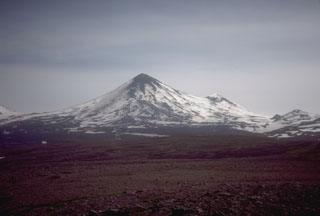Report on Pavlof (United States) — 8 May-14 May 2013
Smithsonian Institution / US Geological Survey
Weekly Volcanic Activity Report, 8 May-14 May 2013
Managing Editor: Sally Sennert.
Please cite this report as:
Global Volcanism Program, 2013. Report on Pavlof (United States) (Sennert, S, ed.). Weekly Volcanic Activity Report, 8 May-14 May 2013. Smithsonian Institution and US Geological Survey.
Pavlof
United States
55.417°N, 161.894°W; summit elev. 2493 m
All times are local (unless otherwise noted)
AVO reported that on 13 May seismicity at Pavlof increased at 0800 commensurate with the presence of an intense thermal anomaly at the summit observed in satellite imagery. Several spikes in seismicity occurred between 0900 and 1000. AVO noted that similar patterns of seismicity and elevated surface temperatures have previously signaled the onset of eruptive activity at Pavlof. Although not yet visually confirmed at the time of the report, a low-level eruption of lava had likely begun from a summit vent. No ash clouds were detected. The Volcanic Alert Level was increased Watch and the Aviation Color Code was increased Orange. On 14 May pilot reports and satellite images confirmed activity; a spatter-fed lava flow advanced about 0.5 km down the N flank. Minor steam-and-ash emissions from the summit were visible from Cold Bay (60 km SW).
Geological Summary. The most active volcano of the Aleutian arc, Pavlof is a Holocene stratovolcano that was constructed along a line of vents extending NE from the Emmons Lake caldera. Pavlof and Pavlof Sister to the NE form a dramatic pair of symmetrical, glacier-covered stratovolcanoes that overlook Pavlof and Volcano bays. Little Pavlof is a smaller cone on the SW flank of Pavlof volcano, near the rim of Emmons Lake caldera. Unlike Pavlof Sister, eruptions have frequently been reported from Pavlof, typically Strombolian to Vulcanian explosive eruptions from the summit vents and occasional lava flows. The active vents lie near the summit on the north and east sides. The largest recorded eruption took place in 1911, at the end of a 5-year-long eruptive episode, when a fissure opened on the N flank, ejecting large blocks and issuing lava flows.
Source: US Geological Survey Alaska Volcano Observatory (AVO)

